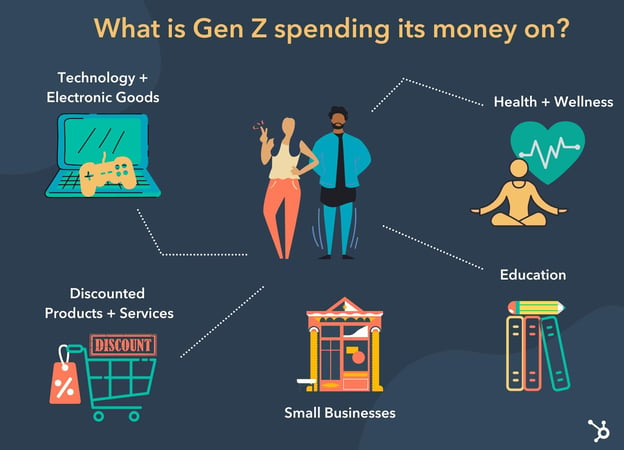With a purchasing power of more than $143 billion, Gen Z is expected to shake up the retail industry.
Although many in Gen Z are earning their first paychecks, entering college, or just joining the workforce, studies show that the generation shops and spends money much differently than its millennial predecessor.
While millennials and past generations were more loyal to brands, Gen Z is more interested in buying products that will give them the best value based on their price. Gen Zers also admits to being more impulsive in their shopping habits than older generations.
A Breakdown of Generation Z’s Spending Habits
When it comes to the total share of spending, Gen Z accounts for an estimated five percent in the U.S., according to Afterpay’s 2021 Next Gen Index. However, that number is expected to grow 10% by 2030, as most will be entering the workforce.
With every age group, generation Z’s spending habits declined at the onset of the COVID-19 outbreak. However, the Afterpay report reveals that Gen Z recovered faster than older generations.
So what are they doing right now? Well, they’re shopping more online.
A 2021 Consumer Culture Report by 5WPR found that Gen Z is now spending 43 minutes more per on online shopping than they did before the COVID-19 outbreak.
They (77%) say online shopping allows them to discover products from new or small companies they wouldn’t find in person. Only 38% say they prefer in-store shopping.
The number one place Gen Z lives online is YouTube. It’s where they spend their time but also where nearly half (47%) research products they’re interested in purchasing, according to the report. Instagram comes next, followed by Snapchat, then TikTok.
The report also suggests that Gen Z is the most passionate when it comes to buying products from brands that align with their values. The study found that 45% of Gen Z have boycotted a business and 36% enjoy buying products that display their social and political beliefs.
Another thing we can expect from Gen Z is their reliance on influencers to recommend products.
A 2021 Survey Monkey report found that this generation trusts influencers the most, with 11% using them as their trusted source for product recommendations – compared to 7% in millennials and 3% and lower in 40+ consumers.
To help brands market to Gen Z when they reach full purchasing power, here’s what we expect them to invest in over the next year.
5 Things Gen Z Will Spend Money On

According to a 2021 Consumer Culture Report by 5WPR, Gen Z is prioritizing electronics and technology along with health and wellness.
Conversely, Millennials and those from older generations prioritize travel and experiences, home goods, and furniture.
Based on additional research, we also found that Gen Z also pays special attention to small businesses. They are also willing to wait for a good discount before making a purchase and take advantage of buy-now-pay-later purchasing options.
Let’s dive into each category below.
1. Electronics and Technology
Gen Z will occasionally splurge on technological experiences that help them have fun, such as video games. In fact, a 2019 study found that two-thirds of Gen Z men say gaming is a “core component” of who they are.
While you might worry that Gen Z isn’t worth marketing to because they won’t splurge on your products, this age group certainly can be persuaded to make larger purchases that offer fun experiences or improve their daily lives.
But, even though they will invest in higher-priced products, Gen Z will still need thorough convincing before pulling out their wallets. It’s incredibly important for brands targeting Gen Z to create content that demonstrates why the age group needs their product, how the product could solve daily boredom or woes, and why it’s better than a competitor’s.
For example, although some consumers might consider Fitbit fitness trackers frivolous, this brand does a great job of explaining why its product can be a necessary tool to use within a fitness routine.
On social media, Fitbit gives facts about why walking and cardio – two activities the bracelet can track – are important to health. And, in a November blog post, Fitbit more deeply connected its product to health needs by discussing how its reporting software could help people communicate better with their doctors.
While Fitbit doesn’t claim its product is necessary for health, the brand shows audiences how the product can be used to help them track their fitness needs and progress.
When a pessimistic or budget-conscious Gen-Z member researches Fitbit, they might find its content informative and helpful. From there, if they’re interested in a healthier lifestyle, they might realize that Fitbit is a credible brand that could help them with their fitness needs.
2. Discounted Goods
Eighty percent of Gen Z surveyed in 5WPR’s report say they will wait for an item to go on sale before buying it.
Why is Gen Z so conscientious about their spending habits? Mounting research suggests that the age groups’ thoughts on money link directly to the economic era they were raised in.
While millennials grew up in more stable financial times, most of Gen Z’s earliest memories took place during the U.S. recession. Much of this generation grew up in highly budgeted households or saw how their families were impacted by economic troubles.
Meanwhile, a large percentage of millennials, as well as those in other age groups, are able to recollect times where their economy was booming.
Organizations including the Pew Research Center say these eras have psychologically molded how each generation thinks differently about money. While researchers believe both millennials and Gen Z are money conscious, with goals of avoiding financial instability, millennials are considered to be “more optimistic” future finances.
As Gen Z ages, studies and purchasing behaviors hint that they haven’t been able to shake their concerns of financial instability. Much research shows that to get Gen Z to invest in a product or service, the offering needs to be so valuable to them that they can justify purchasing it.
A recent Business Insider report revealed that Gen Z isn’t easily persuaded by a logo when it comes to clothing. In fact, unlike other generations, brand loyalty is one of the last things they think about when making a purchasing decision. What the generation does focus on is price and value.
In the report, a 20-year-old named Amanda Chermin explained, “I can’t afford nicer brands of clothes – I like to save and would rather have money in the bank than be broke.”
Instead of splurging on the hottest brand from New York Fashion Week, the age group is more likely to purchase cheaper clothing that’s either not from a name brand, on clearance, or re-sold.
Or they’ll buy now and pay later (BNPL).
Millennials are the leaders of the BNPL model but Gen Z is growing the fastest, accounting for 14% of users on Afterpay in the U.S.
80% of Gen Zers who use the software spend it on fashion. However, wellness, beauty, and recreation are other top categories.
Although they aren’t loyal to the same stores and brands millennials zoned in on, Gen Z still feels pressure to buy and wear clothing that’s considered good quality or fashionable. Aside from purchasing affordable clothing, the need to look their best has also led to many in Gen Z to invest in clothing rental services or try-before-you-buy shopping experiences.
Although Gen Z is expected to spend less money on clothing than other generations, researchers believe they still feel pressure to look good in front of their peers. These pressures, which might stem from social media, school, work, or social environments will still drive the age group to clothing stores or ecommerce sites. While retail marketers should expect shifts in spending behaviors from this generation, Gen Z will still buy clothing that looks good on them, is good quality, and has an affordable price.
The themes related to clothing purchases are important to keep in mind — even if you aren’t marketing clothing products. As we’ve established, Gen Zers are always looking for a good bargain and won’t use just a brand name to justify a purchase.
Regardless of how popular or well-known your brand is, you’ll still need to highlight why your products are better than cheaper versions from competitors.
Although your logo might not persuade Gen Z to buy your product, you can still use authentic brand trust and popularity to your advantage. Although Gen Z is budget-conscious, they also care about what their peers think of them. This means that they might still feel a need to splurge on a product, such as a clothing item if they know that people in their age group have it.
If you’re marketing to Gen Z, consider asking popular influencers or happy young adult customers to discuss your product on social media. An authentic product review will not only build a sense of brand trust, but it will also show Gen Z audiences that the product is popular and being used by people they follow.
From there, a Gen Z member might research or purchase a product simply because it’s more popular or has better reviews than a cheaper alternative.
3. Health and Wellness
In 2019, a survey found that Gen Z was more concerned with mental and physical health than older generations. Today, that still rings true.
Health and wellness is the second-highest category Gen Z spends on, according to 5WPR’s 2021 consumer report mentioned earlier.
In fact, this group seems to be leaders in the wellness movement building over the past few years, which promotes awareness surrounding mental health, ethical food sourcing, other related wellness issues.
For instance, WSL reported that Gen Zers are more likely to use natural remedies than traditional medications, seven points higher than Millennials. They’re also less likely to eat fast food.
The article also highlights how Gen Z also invests more (5% to be exact) in wellness than Millennials, a data point that’s reflected in 5WPR’s 2021 Consumer Culture Report.
4. Small Businesses
Since January 2020, small business spending has increased more than 260% for Gen Z on Afterpay, 80% higher than Millennials.
This conscious effort likely stems in part from the recent pandemic, as many small businesses struggled to survive.
In a June 2021 survey conducted by Sendinblue and CITE Research, 46% of Gen Z consumers said they purchased more from small businesses than pre-pandemic.
Most were driven by the ability to build a strong bond between consumers and contribute to the local economy.
Another interesting reveal is that consumers are more willing to share their data with small businesses, in exchange for discounts and deals. Another caveat is that brands must share how the information will be used.
This is great news for small businesses that are figuring out how to reach Gen Z consumers. It’s an invitation to be more transparent about your business and not be afraid to show what’s happening behind the scenes.
5. Education
Another key component of generation Z’s spending habits is education.
While millennials are one of the most highly educated age groups, Gen Z is on track to have the highest level of education.
In 2020, the Pew Research Center reported that college enrollment is more likely in Gen Zers than Millennials and Gen Xers at a comparable age. They’re also more likely to have a college-educated parent.
At this point, Gen Z’s already been shown to start saving for college at a much younger age than millennials.
As members of the generation enroll in college or begin to spend their own money, news outlets have predicted and reported bursts in school-related purchases fueled by Gen Z shoppers.
Aside from purchasing supplies, Gen Z is also likely to invest in courses or educational programs that will advance their future earnings.
From 2019 to 2020, Gen Z learners watched 50% more hours of educational content on LinkedIn. They also spend 12% more time honing hard skills on LinkedIn Learning than the average learner on the platform.
Ultimately, many researchers believe that Gen Z’s interest in academia is rooted in their need for financial stability. Many in the age group believe that a good education will lead to a great job with high pay.
As a marketer, it’s important to keep Gen Z’s budgeting and educational goals in mind. This generation wants to learn new things, is saving for college, and prioritizes investments that better their future. You’ll need to convince them that your product is worth buying – even when they’re putting most of their money into a college fund.
As you create your product promotions or campaigns, consider how your product could help or benefit the experiences of someone planning for college, college students, or young professionals.
If your product isn’t specifically geared toward education, your campaigns could zone in on how it could improve a college or work-life experience.
For example, if you’re marketing furniture, you could create a promotion that highlights products that would fit in an apartment or dorm room. Or, if you market a clothing company, you could highlight clothing items that could be worn in a job interview in a blog post on your website.
Aside from creating content that directly links your product to career interests or academics, you can also lean into Gen Z’s need to learn new things by developing educational content that teaches audiences about your industry.
After viewing your educational content, audiences might want to learn more about your product and develop a stronger sense of trust for your brand. Later, if they’re interested in buying a product related to your brand’s industry, they might consider your brand first.
If you want to leverage educational content, keep the age range of your audience in mind. While younger members of Gen Z might be primarily interested in B2C brand content due to their college or high-school age, Gen Zers entering internships or the workforce might value educational B2B content that can show them how to get ahead in their industry.
How to Market Based on Gen Z’s Spending Habits
Based on research noted above, Gen Z is less likely to splurge on frivolous products or brand names. As a marketer, hearing about these mounting studies might make you nervous.
But, in the long run, the consumer trend of putting value first shouldn’t scare or shock you. In fact, it should motivate you to ask, “How can I provide better value to my customers?“
Although Gen Z might seem more budget-conscious, this doesn’t mean they won’t buy anything from you at all. In fact, many of your most frugal prospects will still buy, invest in, or splurge on your brand’s offerings if they seem valuable, help them solve pain points, or provide a positive, memorable experience.
Ultimately, bettering your brand, focusing on the customer experience, and promoting positive company reviews will go a long way with Gen Z and all other audiences.
Editor’s Note: This post was originally published in July 2020 and has been updated for comprehensiveness.


![→ Download Now: Free Product Marketing Kit [Free Templates]](https://no-cache.hubspot.com/cta/default/53/08b5e1f4-5d26-405b-b986-29c99bd0cb14.png)


![How to Write a Video Script [Template + Video]](https://vmkagency.com/wp-content/uploads/2024/03/video-outline.pngkeepProtocol-500x383.png)
![The Ultimate Guide to Google Ads [Examples]](https://vmkagency.com/wp-content/uploads/2024/03/adwords-ppc_4.webpkeepProtocol-500x383.webp)
